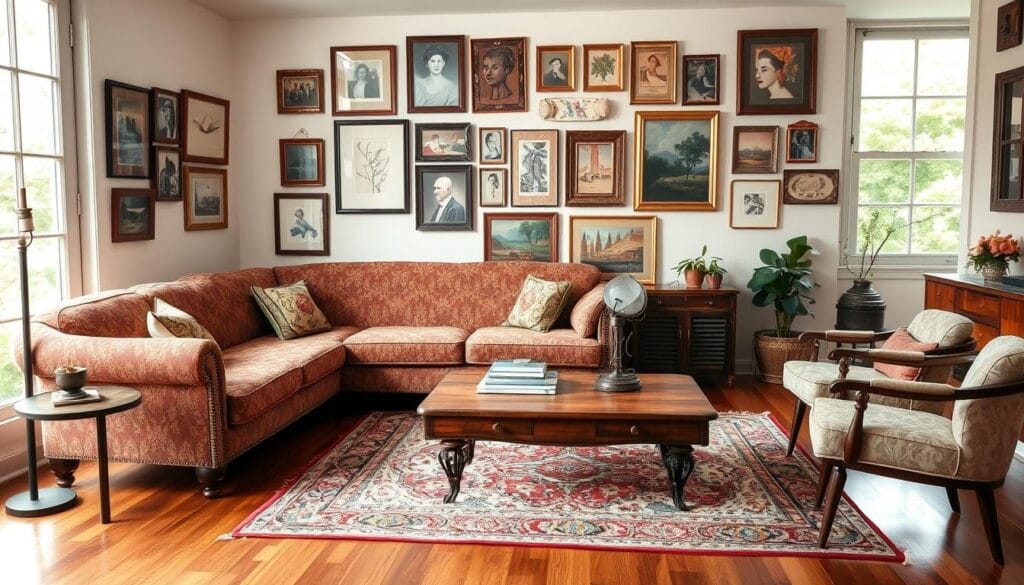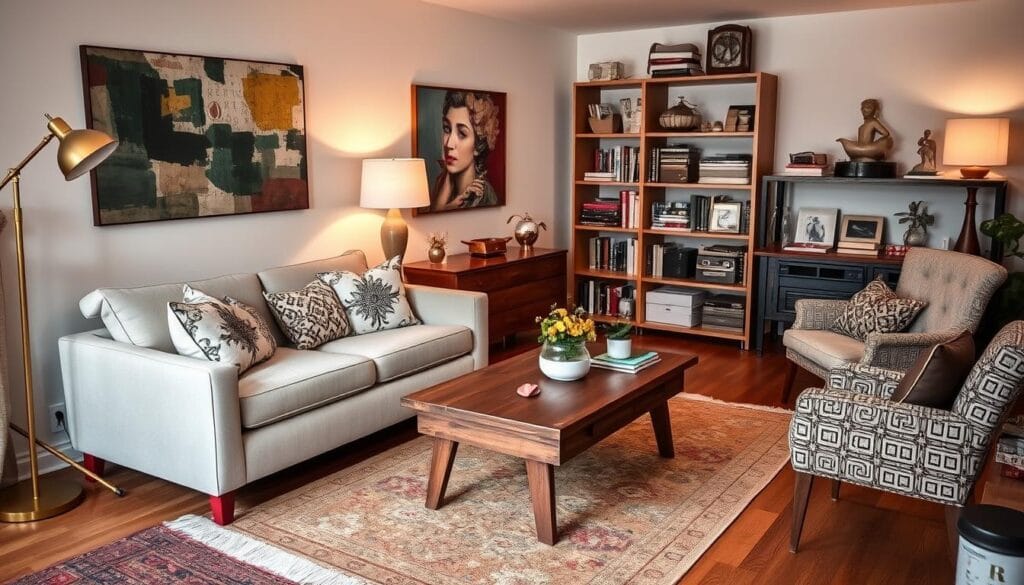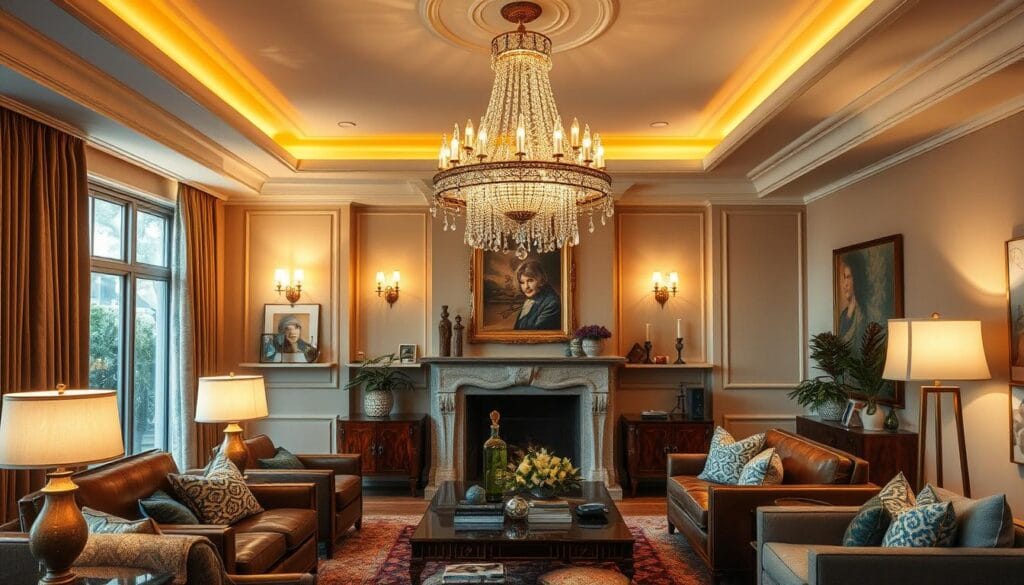Creating a home that shows your personality is key. Mixing vintage decor with modern elements is a smart way to do this. It adds character and makes your home unique. With a few tips, you can turn your home into a stylish, eclectic space.

This article will show you how to blend vintage and modern styles. You’ll learn to pick the right vintage pieces and pair them with modern ones. This way, you can make a space that’s both stylish and personal, perfect for your home.
Key Insights
- Learn how to mix vintage decor with modern elements in your home design
- Discover how to create a unique and stylish space that reflects your personality
- Get tips and tricks for combining old and new pieces in your interior decorating
- Find out how to add character to your space with vintage decor and modern elements
- Transform your home into a beautiful and eclectic space that showcases your individuality
- Understand the importance of balancing vintage and modern elements in your home design and interior decorating
Understanding the Appeal of Mixed-Era Design
Many people love interior design that mixes old and new. This style lets you show off your personality in your home. By mixing vintage and modern items, you can make a space that’s uniquely yours.
This style is all about expressing yourself and being creative. It lets you combine pieces that show off your unique taste. This way, your home can be both nostalgic and modern, showing your love for history and today’s style.
The Psychology Behind Mixed Styling
People who choose mixed-era design want to connect the past and present. They use vintage items in modern spaces. This creates a space that’s both personal and stylish.
Benefits of Combining Old and New
There are many good things about mixing old and new in your home. It makes your space truly unique and shows off your personality. It also adds depth and interest to a room, making it more lively.
- Creating a unique and personalized space
- Adding depth and visual interest to a room
- Reflecting your individuality and style
- Allowing for self-expression and creativity
Current Design Trends in Mixed Decor
Today, mixed-era style is all about mixing old and new in a modern way. You can pair vintage furniture with modern decor or add modern touches to traditional spaces. Some popular trends include:
- Industrial chic
- Vintage modern
- Bohemian eclectic
Essential Design Principles for Mixing Vintage and Modern Elements in Home Decor
Mixing vintage and modern elements in home design can make your space unique and stylish. Understanding interior decorating principles is key. It’s about blending old and new pieces to create a cohesive look.
Balance is crucial for a harmonious space. Use the rule of thirds to divide your space into thirds. This helps balance elements and creates harmony.
Texture and pattern are also important. Mixing textures like wood, metal, and glass adds depth. Here are some tips:
- Combine smooth and rough textures for contrast
- Use patterned rugs and throw pillows for interest
- Add natural elements like plants and wood for warmth
By following these principles, you can create a beautiful space that reflects your style. Don’t forget to have fun and try different combinations. This will help you find the perfect balance for your home.
| Design Element | Vintage | Modern |
|---|---|---|
| Texture | Wood, velvet, lace | Metal, glass, leather |
| Pattern | Floral, stripes, polka dots | Geometric, abstract, solid colors |
| Color | Earth tones, pastels, rich jewel tones | Bold brights, neutral tones, monochromatic |
Creating Balance Through Color Schemes
Color schemes are key in interior design, setting the mood of a room. To achieve balance, pick a color scheme that matches your modern furniture and style. The 60-30-10 rule is helpful, where 60% of the room is a main color, 30% is secondary, and 10% is an accent.
There are many color schemes to choose from, like monochromatic, complementary, and analogous. Monochromatic uses different shades of one color. Complementary colors are opposite each other on the color wheel. Analogous colors are next to each other. Neutral backgrounds bring calm, making a perfect backdrop for your furniture and decor.
Selecting Complementary Color Palettes
To pick a complementary color palette, think about your furniture and the room’s light. Online tools or a professional designer can help find the right colors. Some top picks for modern furniture include:
- Soft gray and white
- Warm beige and brown
- Cool blue and green
Using Neutral Backgrounds
Neutral backgrounds create calm, making a clean space for your furniture and decor. Use a neutral wall color like white, gray, or beige. Add color with throw pillows, blankets, and rugs.
The Art of Furniture Placement
In home design, furniture placement is key. It can change a room’s feel, affecting its flow and harmony. Think about the room’s size, shape, and the furniture’s style and scale. This helps you find the best layout, following interior decorating principles.
Start by thinking about each room’s purpose and how you’ll use it. List the furniture you need. Then, consider these tips:
- Measure the room and furniture to ensure a good fit
- Consider the traffic flow and leave enough space to move around
- Use furniture to create conversation areas and define different spaces within the room
- Don’t forget about lighting and how it can affect the mood of the room
By following these tips, you can make a beautiful and functional space. It will meet your needs and show your style. Remember, furniture placement is an art that needs patience and practice. But with creativity and experimentation, you can create a stunning space that reflects your personal style and flair for home design and interior decorating.

Mixing Textures and Materials
Mixing textures and materials can make your space unique and stylish. Combining wood, metal, and glass creates a balanced look. This section will show you how to mix textures for a harmonious decor.
Texture adds depth and interest to a room. It helps balance and harmonize the space. When mixing, think about furniture, decor, and flooring. Different textures make your space dynamic and interesting.
Combining Different Wood Finishes
Using various wood finishes can add texture. Pair a wooden table with a chair in a different finish for contrast. You can also use the same finish on furniture for continuity.
Incorporating Metals and Glass
Metals and glass add elegance to your space. A metal lamp or glass vase can enhance a room’s look. Choose elements that match your decor’s aesthetic.
Balancing Smooth and Rough Textures
Balance smooth and rough textures for contrast. A smooth leather sofa with a rough wool rug is a good example. This mix creates a cohesive and harmonious space that shows your style.
Statement Pieces: Where Vintage Meets Modern
Statement pieces are key when mixing vintage and modern in your home. They make a room’s focal point, adding personality and style. To find the perfect piece, blend vintage decor with modern furniture for a balanced look.
Here are some tips for picking the right statement piece:
- Look for pieces with an interesting history or story behind them
- Consider the scale and proportion of the piece in relation to the room
- Think about the materials and textures used in the piece and how they will interact with other elements in the room
Adding statement pieces to your decor makes your space unique and shows off your style. Whether you love vintage decor or modern furniture, these pieces tie everything together. They add drama and interest to the room.
Room-by-Room Guide to Mixing Styles
When you want to mix styles in your home, start with each room. A room-by-room guide helps you tackle each space’s unique needs. We’ll show you how to blend vintage and modern in living rooms, bedrooms, kitchens, and dining areas. You’ll learn about key elements for a balanced look.
Using a room-by-room guide, you can make your home both beautiful and functional. Interior design is about finding the right mix of elements. A mixed-era style can make your home stand out. Whether you dream of a cozy living room or a chic bedroom, this guide will help you get there.
Here are some tips for mixing styles in different rooms:
- Living Room: Mix vintage furniture with modern decor and accessories for a unique look.
- Bedroom: Combine vintage bedding with modern furniture and lighting for a cozy feel.
- Kitchen and Dining Area: Blend vintage appliances and decor with modern furniture and lighting for a stylish space.
A mixed-era style requires careful planning and attention to detail. Think about each room’s unique qualities and mix vintage and modern elements. This way, you’ll create a space that shows off your personality and style. Balance your design and enjoy the process of making your space unique, using a room-by-room guide as your guide.
| Room | Vintage Elements | Modern Elements |
|---|---|---|
| Living Room | Vintage furniture, decor | Modern lighting, accessories |
| Bedroom | Vintage bedding, lighting | Modern furniture, decor |
| Kitchen and Dining Area | Vintage appliances, decor | Modern furniture, lighting |
Lighting as a Bridge Between Eras
Lighting is key in mixing old and new in your home decor. The right lights can tie different styles together, making your space unique and stylish. It’s not just about light; it’s about setting the mood and feel of a room.
Vintage lighting can add a nostalgic charm to modern spaces. For instance, a classic chandelier can look great with modern furniture. Or, modern lights with classic touches can flow smoothly together.
Vintage Lighting in Modern Spaces
Here are some tips for vintage lighting in modern homes:
- Look for vintage pieces with unique designs.
- Match vintage lights with modern furniture for contrast.
- Use vintage lights to add color or texture to a room.
Contemporary Fixtures with Classic Elements
Modern lights can also have classic touches. Look for:
- Classic materials like brass or bronze.
- Traditional designs like sconces or chandeliers.
- Ornate details like carvings or etchings.

By mixing these elements, you can create a lighting scheme that’s both modern and timeless. It will enhance your mixed-era style interior design. The goal is to find balance and harmony, and lighting is key to achieving this.
Common Mistakes to Avoid When Mixing Styles
Mixing vintage and modern elements in interior design can make your space unique. But, there are mistakes to avoid for a balanced look. First, think about the overall look you want in your mixed-era style.
People often make mistakes like clashing colors and overwhelming patterns. To fix this, edit and curate your decor with care. Also, think about the flow and harmony of your space. Use neutral backgrounds to balance out bold colors.
Here are more tips to remember:
- Avoid mixing too many different styles or periods in one space
- Use lighting to create a sense of cohesion and harmony
- Don’t be afraid to add your own personal touches and unique pieces
- Consider the overall interior design of your space, and how your mixed-era style fits into it
By following these tips, you can create a beautiful and functional space. Always keep your common mistakes in mind. Stay focused on your vision for your
Maintaining Visual Harmony While Taking Design Risks
Interior design is all about showing off your personality and style. To do this, you need to keep things visually harmonious while being bold with your design choices. Visual harmony means finding the right mix of colors, textures, and patterns to make your space feel calm and balanced.
In a mixed-era style space, keeping things harmonious is even more key. You have to blend different styles and periods to get a cohesive look. Use a standout piece of furniture as a focal point and match colors and textures to link spaces together.
Creating Focal Points
Adding focal points can really make a room pop. You can use anything from a bold piece of furniture to a vibrant rug to draw the eye. The goal is to create drama and interest. In a mixed-era space, pair a vintage piece with modern elements for a striking contrast.
Establishing Flow Between Spaces
Flowing your spaces together is essential for a unified look. Use similar colors, textures, and patterns to connect rooms. For example, sticking to a color scheme across rooms can create a sense of continuity. In a mixed-era space, blend vintage and modern elements to link spaces smoothly.
By following these tips, you can craft a space that’s uniquely yours. Balance elements, create focal points, and ensure flow between spaces to achieve visual harmony in your mixed-era style home.
| Design Element | Visual Harmony Tip |
|---|---|
| Color | Use a similar color scheme in different rooms to create continuity |
| Texture | Mix different textures, such as wood and metal, to add depth and interest |
| Pattern | Use similar patterns, such as stripes and polka dots, to create flow between spaces |
Conclusion: Creating Your Unique Style Story
Starting your journey in mixing old and new in home decor is exciting. It’s all about showing off your unique personality and style. By combining classic and modern elements, you can make a space that’s truly yours.
This article has given you the basics, from choosing colors to arranging furniture. But the real magic happens when you dare to be different. Don’t be afraid to try new things and let your home show off your creativity.
Your home should be a place that feels like you, a place that brings you joy. By following these tips and listening to your gut, you can make a space that’s both beautiful and meaningful. It will be a true reflection of your unique style story.




